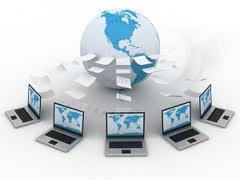
You have already used a form of cloud computing if you have an email account with a Web-based email service such as Gmail, Yahoo! Mail, and Hotmail. The software and storage for your account lies on the service's cloud servers, not on your own computer. Some experts are saying that the desktop PC will soon become obsolete and all that will be needed to do cloud computing in the near future, is to have a monitor connected to an ISP and have the appropriate apps on a smart phone.
The term "cloud" is a fitting metaphor for this emerging use of the Internet... it is infinitely large, somewhere out there in the sky, and all fuzzy around the edges. Cloud computing is. more or less. an umbrella term used to describe a number of different trends; all of them involve the Internet and how computers are used. Most computer experts agree that computing activity and capability will be greatly extended well beyond current levels, and it will completely change how businesses and individuals use the computer.
Industry experts are quite sure that cloud computing will change the future of IT forever, but there is still a lot of speculation on how it will exactly unfold. All the major players are scrambling to get in front of the wave; companies like Google, Amazon, Microsoft, Yahoo, AT&T, Cisco, Hewlett-Packard, Dell, IBM, Intel, Oracle, Unisys, Cognizant, GE, and hundreds more. Even in the face of all this anticipation and excitement, there are a lot of IT professionals who are still quite unsure what it is exactly. They are not sure whether safety and privacy issues can be handled properly, or what kind of impact it will have on their jobs.
Cloud computing generally offers customers more services for less cost; that is the basic advantage and promise. Customers must entrust their personal and business data to remote services, but in exchange, they get to access more software and a broader range of services than they could normally afford otherwise. Cloud customers become members, or subscribers, to cloud service providers at very reasonable fees, and are able to access vast libraries of resources as they need to, and store all their files remotely for safe keeping. The suppliers do all the heavy lifting and supply the infrastructure for the service or software; the customers enjoy all the benefits without having to pay for any of the development costs. All the customers pay for is their monthly use of services, similar to how customers now pay their monthly fees to a utility or telephone company who owns all the wires, poles, and power stations.
Accordingly, some vendors and analysts have defined cloud computing as "utility computing", where data centers are similar to power stations. What power stations did for the use of electricity, data centers are now being constructed to provide virtual servers available to the client base over the Internet. Others have defined it saying that anything digital that is consumed outside the firewall of their personal work stations is "in the cloud". As access to electricity became more available to customers, it spawned all sorts of new inventions to use it. Similarly, it is anticipated there will be an incredible amount of new products and services created for cloud users as the industry develops.
Cloud computing offers a variety of types of services: infrastructure, platform, software, storage, security, data, test environment, desktop, application program interface (API), and hundreds more. For example, customers using software as a service will usually rent the software applications and databases. The cloud providers own and manage the platforms and infrastructure on which the applications run, similarly to how web-hosting is now provided to individual users. Subscribers access cloud-based applications via a web browser, or light-weight mobile or desktop application.





